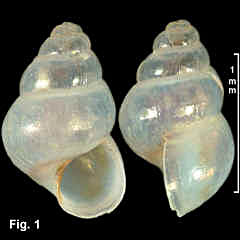|
|
RISSOIDAE |
|
|
|
Lucidestea nitens (Frauenfeld, 1867) Description: Shell short and wide, spire outline weakly convex. Protoconch of about 1¼ whorls, with junction to teleoconch a weak but distinct varix (but protoconch eroded on most shells). Teleoconch up to 3 rounded whorls. Whorls smooth, or with very fine spiral lirae. Aperture subovate, weakly expanded anteriorly, posterior canal well-defined; inner lip reflected over a narrow umbilical slit; outer lip a little thickened externally with low, smooth varix. Shell colourless transparent when fresh, becoming opaque white with age. Inner lip of aperture brown, sometimes also a brown spiral band on base around umbilicus, protoconch sometimes brown. Size: Up to 2.0 mm in length. Distribution: Endemic to Australia: Capricorn Group, Queensland, southwards and around southern Australia to south-western WA, including Tasmania, but see remarks below. Habitat: Empty shells known from beach washup and down to 37 m. Living specimens from intertidal algal and rock washings. Common. Comparison: This is very similar to Powellisetia simillima, which is a subtidal species, while this is mainly intertidal. It is distinguished by the brown inner lip of the aperture and the brown band on the base, if present. Remarks: There is some variation in shell shape and colouration between the Queensland and the southern Australian shells, suggesting there may be more than one species involved over the range. Rissoa atkinsoni Tenison-Woods, 1877 was used for the Tasmania shell until May (1921) synonymised this with the present name, but Ponder (1985) regarded R. atkinsoni as a distinct species. The matter is not yet resolved. Fig. 1: Honeymoon Bay, in Jervis Bay, NSW (C.337473) |
|
